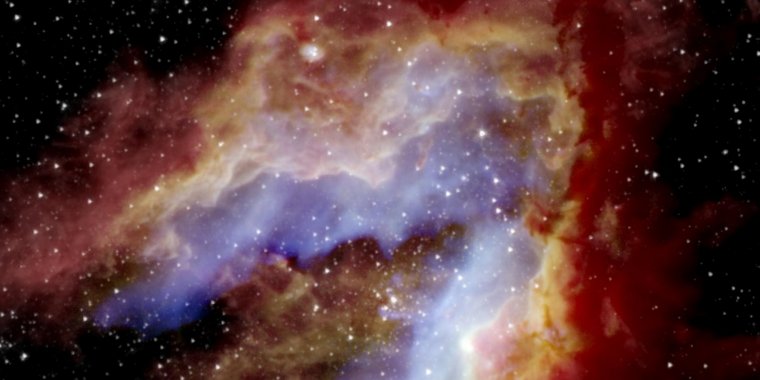| News / Science News |
SOFIA Reveals How the Swan Nebula Hatched
One of the brightest and most massive star-forming regions in our galaxy, the Omega, or Swan, Nebula, came to resemble the shape resembling a swan's neck we see today only relatively recently.

In this composite image of the Omega, or Swan, Nebula, SOFIA detected the blue areas near the center and the green areas. The white star field was detected by Spitzer. SOFIA's view reveals evidence that parts of the nebula formed separately to create the swan-like shape seen today. Credit: NASA/SOFIA/Lim, De Buizer, & Radomski et al.; ESA/Herschel; NASA/JPL-Caltech
New observations reveal that its regions formed separately over multiple eras of star birth. The new image from the Stratospheric Observatory for Infrared Astronomy, or SOFIA, is helping scientists chronicle the history and evolution of this well-studied nebula.
Uncovering the nebula's secrets is no simple task. It's located more than 5,000 light-years away in the constellation Sagittarius. Its center is filled with more than 100 of the galaxy's most massive young stars.
These stars may be many times the size of our Sun, but the youngest generations are forming deep in cocoons of dust and gas, where they are very difficult to see, even with space telescopes. Because the central region glows very brightly, the detectors on space telescopes were saturated at the wavelengths SOFIA studied, similar to an overexposed photo.
SOFIA's infrared camera called FORCAST, the Faint Object Infrared Camera for the SOFIA Telescope, however, can pierce through these cocoons.
The new view reveals nine protostars, areas where the nebula's clouds are collapsing and creating the first step in the birth of stars, that had not been seen before. Additionally, the team calculated the ages of the nebula's different regions. They found that portions of the swan-like shape were not all created at the same time, but took shape over multiple eras of star formation.
The central region is the oldest, most evolved and likely formed first. Next, the northern area formed, while the southern region is the youngest. Even though the northern area is older than the southern region, the radiation and stellar winds from previous generations of stars has disturbed the material there, preventing it from collapsing to form the next generation.
Massive stars, like those in the Swan Nebula, release so much energy that they can change the evolution of entire galaxies. But less than 1% of all stars are this enormous, so astronomers know very little about them. Previous observations of this nebula with space telescopes studied different wavelengths of infrared light, which did not reveal the details SOFIA detected.
SOFIA's image shows gas in blue as it's heated by massive stars located near the center, and dust in green that is warmed both by existing massive stars and nearby newborn stars. The newly-detected protostars are located primarily in the southern areas. The red areas near the edge represent cold dust that was detected by the Herschel Space Telescope, while the white star field was detected by the Spitzer Space Telescope. (NASA)
YOU MAY ALSO LIKE





